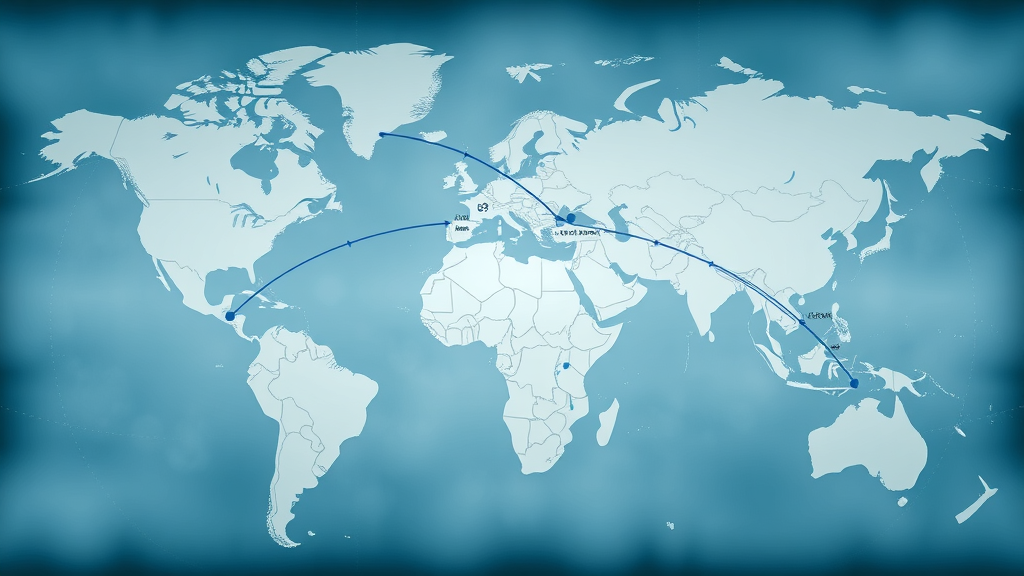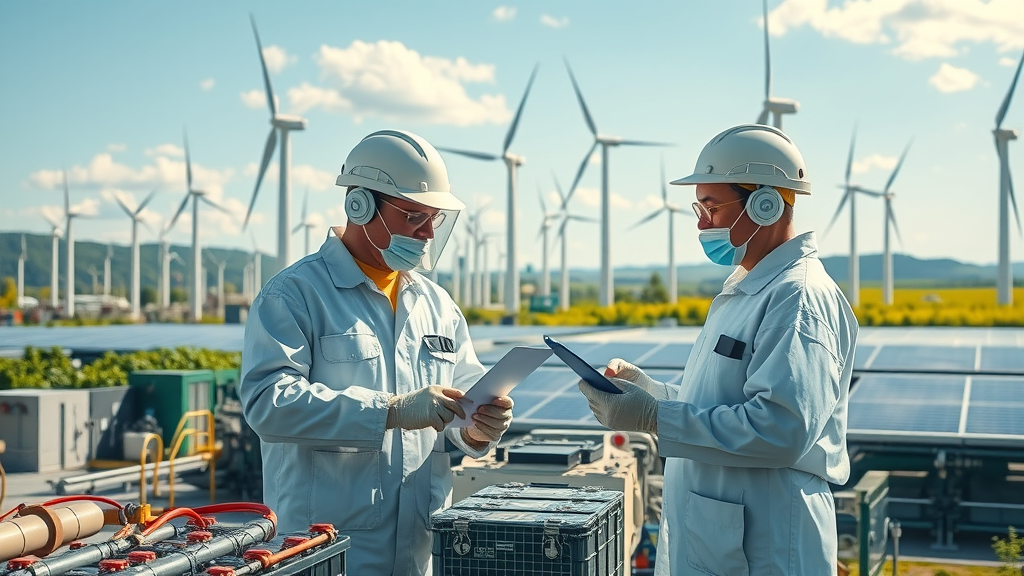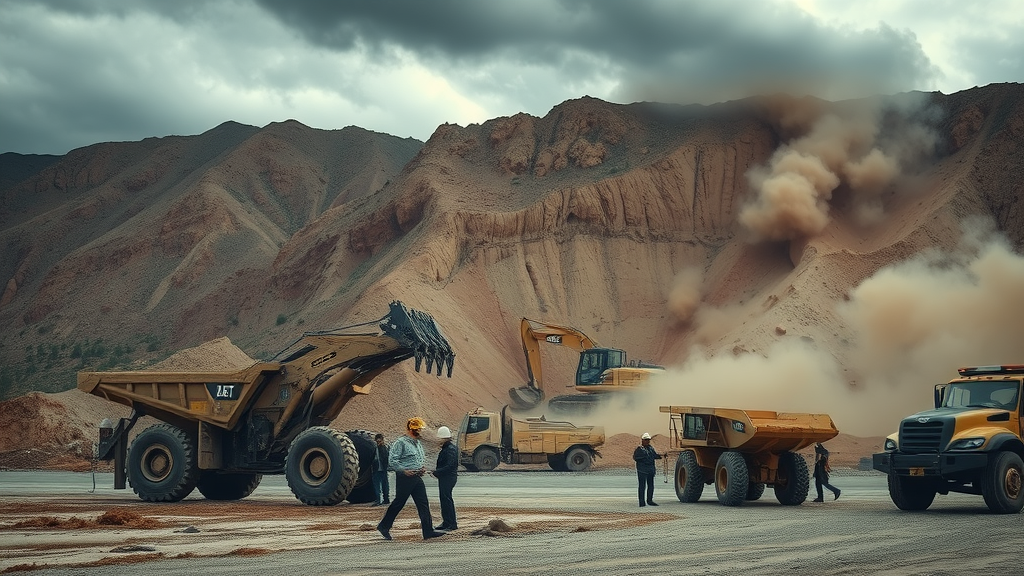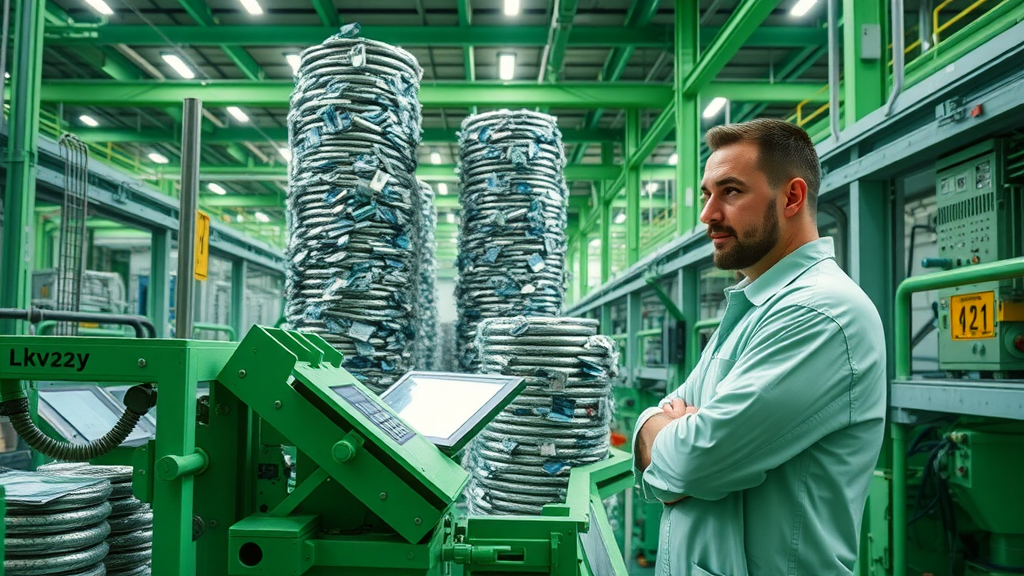Did you know global demand for critical minerals has surged over 500% since 2010? Behind this explosive growth lurks a web of hidden risks, threatening the very backbone of global stability, economic growth, and the future of clean energy. This article uncovers where the critical minerals supply chain is most vulnerable, why these risks matter, and what must be done to fortify our world’s mineral lifeline. Read on to discover how these unseen weak points could reshape our economic and technological destiny—and what steps governments, industries, and individuals can take to secure it.
Exposing the Hidden Weak Points in the Critical Minerals Supply Chain
- Global demand for critical minerals has surged over 500% since 2010—yet vulnerabilities in the critical minerals supply chain threaten global stability and economic growth.

The critical minerals supply chain is rife with blind spots that many industries and policymakers are only beginning to address. Despite the essential role these minerals play in everything from smartphones to wind turbines and electric vehicles, overreliance on limited sources, fragile transport links, and complex global dependencies make the system dangerously brittle. As a result, a single disruption—whether it be political, environmental, or economic—can have cascading effects, stalling clean energy projects, national security initiatives, and even everyday technology production.
The world’s newfound appetite for minerals like lithium, nickel, cobalt, and rare earth elements has forced businesses and governments to confront uncomfortable truths. Concentrated supplies, politically sensitive trade routes, and underinvestment in resilience leave the global supply chain exposed. These cracks threaten not only national energy and security interests but also the ambitious goals set by the clean energy revolution. Industry leaders, policymakers, and concerned citizens must now reckon with these realities, charting a future that’s informed by urgency, foresight, and a willingness to act.
Understanding the Critical Minerals Supply Chain: Foundations and Dynamics
Definition and Importance of Critical Minerals in Supply Chains
Critical minerals are essential raw materials needed for the production of advanced technologies, renewable energy systems, defense applications, and modern electronics. What makes these minerals "critical" is their dual profile of being indispensable to the economy and national security, yet highly susceptible to disruption due to their concentrated production and complex supply chains. As global supply chains intertwine, these minerals often traverse continents before reaching their final destination—multiplied with risks at every stage.
The mineral supply chain encompasses every phase: extraction, processing, refining, transport, and manufacturing integration. Disruptions at any node—from a single mining region to a heavily trafficked shipping lane—can stall entire industries. Robust minerals supply chains are thus vital for countries looking to maintain technological leadership, sustain energy transitions, and safeguard national security. But as reliance on these materials intensifies, so does the exposure to geopolitical, economic, and environmental vulnerabilities.
Ultimately, resilience in the critical minerals supply chain impacts not just governments and corporations, but everyday life. From affordable electric vehicles to access to the latest electronics, the seamless flow of these minerals underpins modern living. Understanding where the pressure points lie is the first step toward insulating societies from the fallout of unforeseen disruptions.
Map of the Global Critical Minerals Supply Chain
Visualizing the global critical minerals supply chain paints a picture of deep interdependence. Key mining regions are often found in a handful of countries—such as China, Australia, and Chile—while processing is further concentrated, with China commanding a staggering share of certain minerals’ refinement and export. Raw materials are shipped through lengthy and sometimes politically fraught routes before being incorporated into products spread across Asian, European, and North American factories.
This mosaic of extraction, processing, and distribution is accentuated by vivid chokepoints—from the Strait of Malacca to South American export corridors—that, if disrupted, can have instant worldwide implications. Ships, railways, and logistics hubs coordinate the flow, requiring sophisticated management and international coordination. Global supply chains work remarkably well—until they don’t, at which point nations and industries can find themselves grappling with shortages and soaring prices.
The minerals supply chain map underscores not only the economic opportunities but the urgency of building redundancy, transparency, and international partnerships. Recognizing the webs of dependency highlights why strategic planning, investment, and innovation are vital for future-proofing against sharp shocks.
| Country | Main Mineral(s) | Export Share (%) | Notable Vulnerabilities |
|---|---|---|---|
| China | Rare Earth Elements, Graphite | 60-90 | Geopolitical risk, export quotas, environmental regulation |
| Australia | Lithium, Nickel | 30-60 | Export dependence, shipping bottlenecks |
| Democratic Republic of Congo | Cobalt | 70 | Political instability, labor practices |
| Chile | Lithium, Copper | 50 | Resource nationalism, water scarcity |
| United States | Beryllium, Helium | 15 | Limited refining, import reliance |
How Critical Minerals Impact the Energy Transition and Clean Energy Revolutions
Critical Minerals and Their Role in Sustainable Energy
Accelerating the global energy transition requires a new generation of sustainable technologies—solar panels, wind turbines, electric vehicles, and grid-scale batteries—all of which depend on a constant supply of critical minerals . These minerals not only form the backbone of renewable energy infrastructure but also enable energy storage, power electronics, and transmission systems essential for a modern grid.
Without a reliable minerals supply chain , ambitions to decarbonize energy systems and meet international climate goals risk stalling. Take the rare earth elements crucial for high-performance magnets used in wind turbines, or lithium and cobalt at the heart of advanced batteries. Any gap or instability in accessing these components can slow down new installations, delay clean energy adoption, and drive up costs for consumers.
The promise of clean energy is inseparable from the health of the critical mineral supply chain . Governments and industry leaders now increasingly incorporate mineral security into their energy and climate strategies, recognizing that policies which overlook supply chain risks may inadvertently undermine the very solutions they seek to promote.

Rare Earth Element Demand in the Energy Transition Era
- Batteries, wind turbines, and solar panels rely on rare earth elements and critical minerals, making the supply chain central to clean energy development.
As demand for renewables surges, rare earth element dependency has grown even sharper. Technologies like electric vehicle motors, high-efficiency wind turbines, and energy-saving LED lights all require a consistent supply of rare earth elements such as neodymium, dysprosium, and terbium. These elements enable higher energy densities, more efficient devices, and longer-lasting products—cornerstones of a sustainable, electrified future.
Yet as the call for clean energy intensifies, production bottlenecks and geopolitical risks add tension to already stretched supply chains . For instance, China’s dominance in rare earth processing places considerable leverage in the hands of a single nation, raising questions about energy security for the United States, the European Union, and other regions. With green tax credits and policy targets further boosting demand, ensuring a secure and diversified minerals supply chain becomes central to delivering on the promise of the energy transition.
This high-stakes balancing act places the critical minerals supply chain at the nexus of innovation, policy, and international relations, demanding unprecedented coordination and resilience planning to ensure the lights (and turbines) stay on as the world transitions from fossil fuels to renewables.
Key Vulnerabilities in the Global Critical Minerals Supply Chain
Single Points of Failure: Geopolitical Concentration

One of the most glaring vulnerabilities in the critical minerals supply chain is the concentration of mining and refining capacity within a handful of countries—often with volatile geopolitics. For instance, China processes over 80% of the world’s rare earth elements, and the Democratic Republic of Congo holds nearly three-quarters of global cobalt reserves. Such concentration means the entire minerals supply chain can hinge on the policies, stability, and international relations of a single nation.
When diplomatic relations sour or trade wars erupt, access to these minerals can evaporate overnight. Tariffs, export restrictions, and diplomatic tensions between mineral-rich countries and major consumers like the United States or European Union have already disrupted markets, spiked prices, and forced industries to scramble for alternatives. The specter of a single country wielding disproportionate influence over critical resources underscores a core challenge: building redundancy and diversity into the modern minerals supply chain .
In this politically charged environment, the push for resource nationalism and strategic reserves grows stronger. Yet, without international cooperation and transparent agreements, even the best-prepared nations remain exposed to sudden shocks in their critical mineral supply chain .
Critical Mineral Supply Instability: Natural Disasters and Trade Conflicts

Natural disasters—earthquakes, landslides, floods, and storms—pose unpredictable threats to mining sites and transport infrastructure. A single incident can halt extraction, damage transport routes, and push commodity prices skyward within days, stalling multiple industries downstream. When these disasters strike regions with concentrated mineral production, the entire critical minerals supply chain can face months of turmoil.
Parallel to environmental risks are the ever-present dangers of trade conflicts. Sudden policy shifts, export bans, and renegotiated trade agreements can upend established mineral flows overnight. The weaponization of mineral exports—as seen in recent disputes between China and the United States—reminds us that access to resources is as much about diplomacy and geopolitics as it is about geology and engineering. This constant threat of instability has forced industries and nations alike to reassess and redesign their approach to minerals security.
In short, both nature and politics can swiftly unravel even the most robust critical mineral supply chains , making agility and contingency planning vital for continued industrial progress and national security.
Logistical and Infrastructural Bottlenecks in Minerals Supply Chains
Complex minerals supply chains depend not just on mines and refineries, but also on the uninterrupted flow through global logistics networks—ports, railways, shipping lanes, and customs channels. Unfortunately, aging infrastructure, limited investment, and inadequate capacity create pinch points where delays, congestion, and even systemic failures can occur. As supply volumes swell with global demand, these bottlenecks put additional pressure on already stretched supply systems.
Unexpected blockages—a port closure, rail strike, or tanker incident—can cascade through the entire supply chain , triggering shortages, price hikes, and production slowdowns. In recent years, major delays at shipping hubs and on transoceanic routes have reverberated through industries reliant on critical minerals for just-in-time manufacturing.
To break free of these choke points, stakeholders must prioritize infrastructure upgrades, digital tracking technologies, and diversified routing options. Only then can the critical minerals supply chain withstand the mounting stress of a rapidly evolving economic landscape.
| Disruption Type | Example | Economic Consequence |
|---|---|---|
| Geopolitical embargo | China rare earth export ban (2010) | Global price spikes, supply shortages, manufacturing delays |
| Natural disaster | Chile mining floods (2015) | Temporary copper shortages, increased market volatility |
| Logistics failure | Port of Los Angeles bottleneck (2021) | Long shipment delays, inventory disruptions in tech and auto |
| Trade conflict | US-EU tariffs on metals (2018-2019) | Higher input costs, trade diversions, strained alliances |
Spotlight on Rare Earth Elements: High Stakes in the Critical Minerals Supply Chain
The Strategic Role of Rare Earth Elements in Technology and Defense

Rare earth elements occupy a unique position due to their indispensable role in both modern technology and national defense. These elements are fundamental in manufacturing precision-guided munitions, stealth aircraft, sophisticated radar systems, and a host of civilian applications, from electric vehicles to consumer devices. Their properties—such as powerful magnetism, high thermal stability, and optical efficiency—make them irreplaceable in a fast-evolving technological landscape.
This dependence translates directly into national security concerns. Countries unable to secure a steady flow of rare earths face the prospect of constrained manufacturing, delayed military readiness, and vulnerability to international leverage. As geopolitical competition intensifies, the rare earth supply chain becomes a front line in the broader contest for technological and military superiority.
Thus, protecting and diversifying rare earth sources—through domestic production, recycling, and alternative materials—emerges as a policy imperative for the world’s major powers. The stakes in the critical minerals supply chain are nothing short of technological and strategic resilience in the 21st century.
Risks Inherent in the Minerals Supply Chain for Rare Earth Elements
The rare earth elements supply chain is exposed to a myriad of unique risks. Highly specialized extraction and refining processes require substantial expertise, environmental oversight, and long lead times, making the entire pipeline slow to adapt to market or political shocks. Moreover, the mining and processing of rare earths can generate significant environmental externalities, amplifying regulatory and social pressure on producers.
Supply disruptions—whether from stricter environmental regulations, global pandemics, or sanctions—can reverberate across a host of industries, triggering ripple effects from defense to consumer electronics. With few viable substitutes and lengthy development horizons for new mines, rare earth supply chains remain a persistent point of vulnerability.
This vulnerability underscores the importance of proactive policies, robust research and development, and agile private sector strategies for both resource-rich and dependent nations.
Minerals Security: Addressing National and Economic Risks
Policy Responses and International Cooperation for Critical Minerals Security
To counter risks in the critical minerals supply chain , governments are enacting a wave of new policies. These include tax credits for domestic production, investment in research and refining, and measures to secure stable trade relationships. The European Union, United States, and other major economies are now crafting strategies to reduce dependency on single suppliers and to foster international cooperation through multi-lateral agreements and resource sharing initiatives.
Beyond domestic measures, minerals security is increasingly treated as a matter of global collaboration. The establishment of strategic reserves, harmonized environmental standards, and reciprocal trade pacts are becoming the norm in response to mounting challenges. Coordinated action, transparency, and intelligence sharing among like-minded economies help mitigate risks stemming from geopolitical concentration and market manipulation.
However, effective global action demands enduring commitment and trust. International dialogues—between the United States, European Union, Australia, and emerging economies—must prioritize stable supply access, sustainable practices, and technology sharing to future-proof the minerals supply chain.
Corporate Strategies to Reduce Supply Chain Vulnerabilities
Corporations at the heart of the minerals supply chain are adopting innovative risk management tactics. Diversifying supplier bases, investing in recycling and alternative materials, and building buffer inventories are now central practices. Technology giants, automotive manufacturers, and green energy firms are forming direct partnerships with miners to secure long-term contracts, often in exchange for funding sustainable extraction or processing upgrades.
Digital tools—such as real-time tracking and predictive analytics—are deployed to preempt and respond to disruptions. Forward-looking companies are also investing in circular economy initiatives, closing the loop by recovering valuable minerals from used electronics and batteries. These strategies not only improve resilience but also align with growing regulatory and consumer demand for sustainable practices.
Ultimately, strong corporate and government alignment—anchored in shared transparency, sustainability, and flexibility—can transform fragile mineral supply chains into engines of growth and innovation.
“The stability of the critical minerals supply chain is the linchpin of our technological and energy future.” — Analyst, Global Trade Institute

What Can Be Done? Reducing Risks in the Critical Minerals Supply Chain
- Diversifying supply sources
- Strengthening recycling and circular economy initiatives
- Strategic reserves and stockpiling
- Building robust international alliances
List of Best Practices for Minerals Supply Chain Resilience

Building a resilient critical minerals supply chain requires multilayered best practices. First, countries and companies need to actively foster multiple supply sources, reducing overreliance on individual nations. Second, the promotion of robust recycling industries—enabling a circular economy for metals and minerals—can transform waste into strategic resources.
Strategic reserves—stockpiling essential minerals—provide buffers against sudden shocks, allowing time for supply chain re-routing and crisis management. Complementing these efforts, international alliances and trade agreements can harmonize standards, facilitate knowledge sharing, and ensure timely access to vital resources during disruptions.
These measures, when pursued in tandem, form the core of a proactive strategy—future-proofing society’s technological and energy ambitions against both foreseeable and unforeseen supply chain risks.
Perspectives: Why the Critical Minerals Supply Chain Deserves Global Attention
“Ignoring the risks in the minerals supply chain could set back the clean energy transition by years.” — Senior Energy Analyst

Expert Viewpoints on Future Disruptions in Critical Mineral Supply
Industry experts agree: the vulnerabilities in the critical minerals supply chain represent an urgent wake-up call. The accelerating demand for rare earth elements, lithium, cobalt, and other strategic resources will test the system at every point—extraction, refining, transport, and recycling. Without robust investment and cooperation, even minor incidents could escalate into significant global crises, affecting national security, climate goals, and everyday technology availability.
Looking ahead, some analysts predict that climate-related disruptions and increased resource nationalism could amplify instability, while others are optimistic that technological innovation and policy reforms will bolster resilience. The consensus, however, is clear—inaction is not an option. The world must mobilize now to ensure a transparent, ethical, and secure minerals supply chain , capable of supporting the next era of industrial and clean energy revolutions.
The challenge, then, is not just technical or economic—it is profoundly strategic and moral. The stakes extend far beyond profits and politics, encompassing the health, prosperity, and security of future generations.
People Also Ask: Insights into the Critical Minerals Supply Chain
What is a critical mineral supply chain?
A critical mineral supply chain refers to the sequence of processes and stakeholders involved in extracting, processing, and delivering essential minerals required for industrial, technological, and energy needs. These supply chains are crucial but often vulnerable to disruptions due to geopolitical, environmental, and market factors.
Who is the biggest exporter of critical minerals?
China stands as the world's largest exporter of many critical minerals, especially rare earth elements, controlling significant portions of the supply chain and influencing global trade and security dynamics.
What are the 12 critical and strategic minerals?
The 12 critical and strategic minerals often include lithium, cobalt, nickel, rare earth elements, graphite, manganese, tin, tungsten, vanadium, niobium, tantalum, and zirconium—subject to government listings and changing strategic focuses.
What are the 35 critical minerals?
The United States’ official list covers 35 critical minerals, such as aluminum, antimony, barite, beryllium, chromium, cobalt, fluorite, graphite, lithium, magnesium, manganese, nickel, rare earth elements, tin, and uranium, among others.
Quick FAQ: Addressing Common Questions About the Critical Minerals Supply Chain
- What are rare earth elements?
- How do critical minerals affect daily life?
- How can countries secure critical mineral supply chains?
Key Takeaways On the Critical Minerals Supply Chain
- Rapid demand growth and supply concentration lead to increased risks.
- National security, technology, and clean energy are all dependent on a stable minerals supply chain.
- Policy, industry, and multinational cooperation are essential to build resilience.
Next Steps for Industry, Governments, and Global Stakeholders
- Enhance supply chain transparency
- Invest in sustainable extraction and recycling.
- Foster international collaboration for minerals security.
Have insights to share on global trade? Let's talk—call us at 203-271-7991 to explore contributing an article.
Proactive coordination, innovation, and global partnerships are critical to securing the future of the critical minerals supply chain—act now to protect progress and prosperity.
The critical minerals supply chain is facing significant challenges due to geopolitical tensions and concentrated production. For instance, China’s recent export restrictions on minerals like gallium, germanium, and antimony have highlighted the vulnerabilities in global supply chains. ( www2.deloitte.com ) Additionally, the United States has taken steps to reduce dependence on foreign suppliers by investing in domestic production, such as the Department of Defense’s $400 million investment in MP Materials to bolster rare earth magnet manufacturing. ( ft.com ) These developments underscore the importance of diversifying supply sources and strengthening international cooperation to ensure a stable and secure supply of critical minerals.
 Add Row
Add Row  Add
Add 




Write A Comment